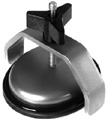I think everyone has good points re: expense (you'd probably want an oilless diaphragm vacuum pump which might be a couple hundred bucks) and the fact that corny keg lids aren't designed to handle negative pressures.
But just for the record a full vacuum is only -14.7 psig. That's absolutely not going to destroy a stainless steel keg rated for 160 psi. The lid would need to be replaced with one meant for vacuum, and if you're really interested (and already have a vacuum pump lying around) you can buy lids that are rated for vacuum. I'm not sure what size you'd need for a corny keg, but at work I use corny-like pressure vessels from Alloy Products Corp, they sell vacuum lids that look like this, but they're around $50:
You will lose CO2 as you transfer the beer, but with a standard (rough) vacuum pump and a quick transfer you probably won't lose all of it. You can always use the vacuum pump to empty the keg and/or prime the siphon, that would probably do a great job eliminating all the O2. But it's really not worth the cost, time, trouble, etc. when siphoning then purging a couple times works just fine. Is it really that hard to sanitize an autosiphon? It really just takes a second.












































![Craft A Brew - Safale S-04 Dry Yeast - Fermentis - English Ale Dry Yeast - For English and American Ales and Hard Apple Ciders - Ingredients for Home Brewing - Beer Making Supplies - [1 Pack]](https://m.media-amazon.com/images/I/41fVGNh6JfL._SL500_.jpg)











 Ahh I see, thanks.
Ahh I see, thanks.


